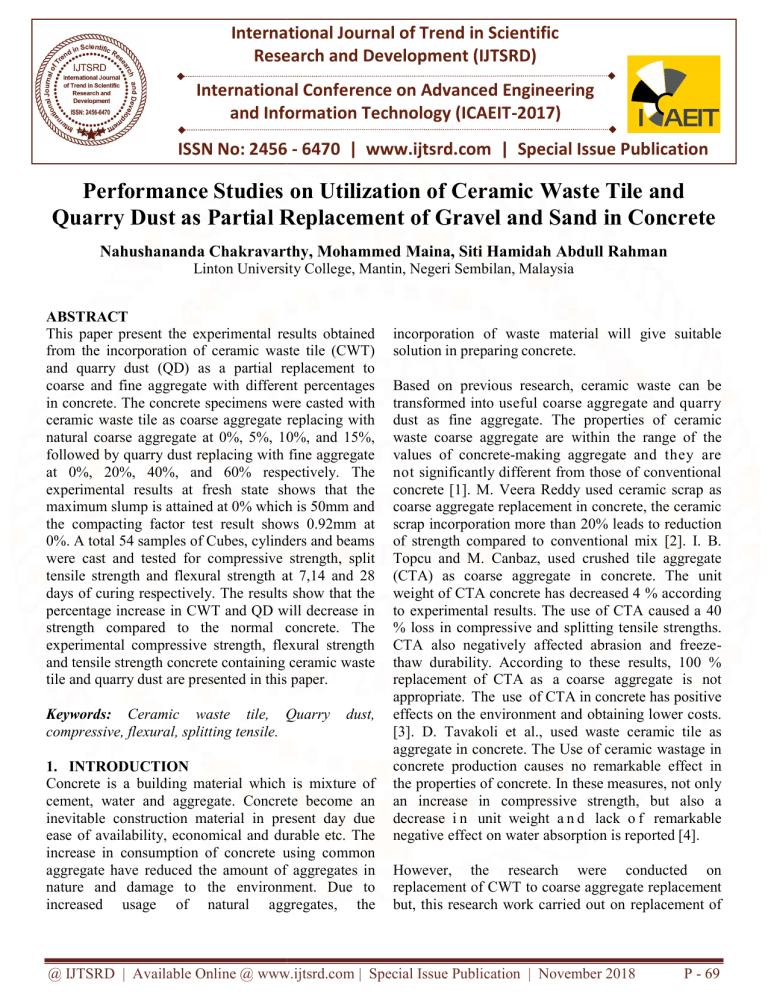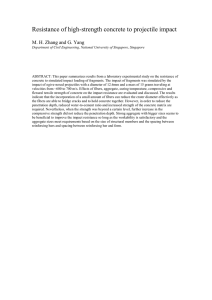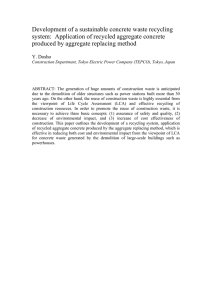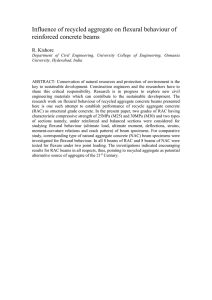
International Journal of Trend in Scientific
Research and Development (IJTSRD)
International Conference on Advanced Engineering
and Information Technology (ICAEIT
(ICAEIT-2017)
ISSN No: 2456 - 6470 | www.ijtsrd.com | Special Issue Publication
Performance Studies on Utilization off Ceramic Waste Tile and
Quarry Dust as Partial Replacement of Gravel and Sand in Concrete
Nahushananda Chakravarthy, Mohammed Maina, Siti Hamidah Abdull Rahman
Linton University College, Mantin, Negeri Sembilan, Malaysia
ABSTRACT
This paper present the experimental results obtained
from the incorporation of ceramic waste tile (CWT)
and quarry dust (QD) as a partial replacement to
coarse and fine aggregate with different percentages
in concrete. The concrete specimens were casted wi
with
ceramic waste tile as coarse aggregate replacing with
natural coarse aggregate at 0%, 5%, 10%, and 15%,
followed by quarry dust replacing with fine aggregate
at 0%, 20%, 40%, and 60% respectively. The
experimental results at fresh state shows that the
maximum
aximum slump is attained at 0% which is 50mm and
the compacting factor test result shows 0.92mm at
0%. A total 54 samples of Cubes, cylinders and beams
were cast and tested for compressive strength, split
tensile strength and flexural strength at 7,14 and 28
days of curing respectively. The results show that the
percentage increase in CWT and QD will decrease in
strength compared to the normal concrete. The
experimental compressive strength, flexural strength
and tensile strength concrete containing ceramic waste
tile and quarry dust are presented in this paper.
Keywords: Ceramic waste tile, Quarry
compressive, flexural, splitting tensile.
dust,
1. INTRODUCTION
Concrete is a building material which is mixture of
cement, water and aggregate. Concrete
ete become an
inevitable construction material in prese
esent day due
ease of availability, economical and duurable etc. The
increase in consumption of concrete us
using common
aggregate have reduced the amount off aggregates in
nature and damage to the environm
ment. Due to
increased usage of natural agggregates, the
incorporation of waste mate
terial will give suitable
solution in preparing concrete.
ete.
Based on previous research, ceramic waste can be
transformed into useful coarse aggregate and quarry
dust as fine aggregate. Thee properties of ceramic
waste coarse aggregate are within
w
the range of the
values of concrete-making
g aggregate and they are
not significantly different from
m those of conventional
concrete [1]. M. Veera Reddy
y used ceramic scrap as
coarse aggregate replacement in concrete, the ceramic
scrap incorporation more than
n 20% leads to reduction
of strength compared to conv
nventional mix [2]. I. B.
Topcu and M. Canbaz, used
ed crushed tile aggregate
(CTA) as coarse aggregate
te in concrete. The unit
weight of CTA concrete has decreased
d
4 % according
to experimental results. The use
u of CTA caused a 40
% loss in compressive and sp
plitting tensile strengths.
CTA also negatively affected
ted abrasion and freezethaw durability. According
g to these results, 100 %
replacement of CTA as a coarse aggregate is not
appropriate. The use of CTA
A in concrete has positive
effects on the environment an
nd obtaining lower costs.
[3]. D. Tavakoli et al., used
ed waste ceramic tile as
aggregate in concrete. The Use of ceramic wastage in
concrete production causes no
n remarkable effect in
the properties of concrete. In these
t
measures, not only
an increase in compressivee strength, but also a
decrease i n unit weight a n d lack o f remarkable
negative effect on water absorp
orption is reported [4].
However, the research were conducted on
replacement of CWT to coarse aggregate replacement
but, this research work carried
ied out on replacement of
@ IJTSRD | Available Online @ www.ijtsrd.com | Special Issue Publication | November 2018
P - 69
International Journal of Trend in Scientific Research and Development (IJTSRD) | ISSN: 2456-647
CWT to coarse aggregate and replacement of quarry
dust to fine aggregate.
2. Materials
2.1 Cement
The term cement refers to a powdery material that
binds. Cement act as a binding agent. In this research
work ordinary Portland cement was used. This type
of cement is generally used for all construction
purpose.
2.2 Coarse aggregate
The selection of appropriate type of coarse
aggregate has a direct influence on the strength of
concrete. Coarse aggregate constitutes gravel or crush
stone. Gravel of maximum size 20mm was used in
this research.
2.3 Fine aggregate
The fine aggregate was dried under steady room
temperature for about two days to acquire a dry and
appropriate condition for mixing. River sand was
used as fine aggregate in this research. The grading
of the fine aggregate was observed to prevent the
likely block of the voids and appropriate penetration
of the mortar.
2.4 Water
Water is used for the hydration of cement in order to
bind with aggregates. The normal tap water available
in the laboratory used in this research. The water was
clean and free from any other impurities.
2.5 Ceramic waste tile
The ceramic waste tile used in this research work was
obtained from oriental ceramic tile industry at
seremban, Malaysia. The preparation of the ceramic
waste tile involves the breakage of the tiles into small
pieces of about 5mm – 40mm sizes by a hammer.
These small pieces are then fed into vibrator and
sieved to get the required coarse aggregate size.
Figure1. Ceramic waste tile
2.6 quarry dust
The quarry dust for this research work was collected
from a quarry near betang benar, Malaysia. The
quarry dust was sieved until the ideal fine aggregate
size was achieved. The sizes of the quarry dust is
between2.36mm to 150 μm.
Figure1. Quarry dust
3. Mix proportions
The mix proportion for the concrete used for
compressive strength, flexural strength and split
tensile strength are as shown in Table 1, Table 2 and
Table 3.
Table 1: Mix proportion for a cube compressive strength
Materials (%) Water content Cement content Fine aggregate Coarse aggregate
QD
sand
CWT
gravel
5 %CWT
0.74
1.48
0.591 2.362
0.221
4.207
20% QD
10 % CWT
0.74
1.48
1.181 1.771
0.443
3.985
40% QD
15% CWT
0.74
1.48
1.771 1.181
0.664
3.764
60% QD
4. Results and discussions
In this study performance of CWT and QD
incorporated concrete were observed in fresh and
hardened state. The performance of fresh concrete
measured using slump and compaction factor test and
hardened concrete measured using compressive,
flexural and spilt tensile strength tests.
@ IJTSRD | Available Online @ www.ijtsrd.com | Special Issue Publication | November 2018
P - 70
International Journal of Trend in Scientific Research and Development (IJTSRD) | ISSN: 2456-647
4.1 Slump test
Fresh concrete must be workable only when it easily
placed, compacted, transported and casted easily
without segregation. In this study concrete was tested
for workability before the concrete placing into the
moulds. The mix combination of all replacement
materials at different percentage of CWT 5%, 10%,
15% and QD 20%, 40%, 60% were used. The
results of the slump test are as shown in Table 4.
Table 4: Slump test
Batch Replacement of materials (%) Slump
No
(mm)
CWT (%)
QD (%)
1
0%
0%
50
2
5%
20%
46
3
5%
40%
43
4
5%
60%
42
5
10%
20%
41
6
10%
40%
39
7
10%
60%
36
8
15%
20%
32
9
15%
40%
31
10
15%
60%
30
In Table 4, the results of slump test with the replacement materials 5% CWT, 20% QD, 10% CWT, 40% QD
and 15% CWT, 60% QD are shown. The result of the slump test specifies that the highest
slump was obtained at the control sample mix with 0% CWT and 0% QD which was 50mm. Hence, increase
in percentage of CWT and QD will not be a good workable concrete.
Table2: Mix proportion for a flexural test specimen
Materials (%) Water content Cement content Fine aggregate Coarse aggregate
QD
sand
CWT
gravel
5 %CWT
1.11
2.22
0.886 3.542
0.332
6.31
20% QD
10 % CWT
1.11
2.22
1.771 2.657
0.664
5.978
40% QD
15% CWT
1.11
2.22
2.657 1.771
0.996
5.646
60% QD
Table3: Mix proportion for a split tensile test
Materials (%) Water content Cement content Fine aggregate Coarse aggregate
5 %CWT
20% QD
10 % CWT
40% QD
15% CWT
60% QD
QD
sand
CWT
gravel
0.407
0.814
0.325
1.299
0.122
2.313
0.407
0.814
0.65
0.974
0.244
2.192
0.407
0.814
0.974
0.65
0.365
2.070
4.2 Compaction factor test
The mix proportions of replacement materials at different percentage of CWT 5%, 10%, 15% and
QD 20%, 40%, 60% were used in compaction factor test. The results of the compaction factor test are as
shown in Table 5.
@ IJTSRD | Available Online @ www.ijtsrd.com | Special Issue Publication | November 2018
P - 71
International Journal of Trend in Scientific Research and Development (IJTSRD) | ISSN: 2456-647
Table 5: Compaction factor test
Batch Replacement of materials (%) C.F
No
(mm)
CWT (%)
QD (%)
1
0%
0%
0.92
2
5%
20%
0.89
3
5%
40%
0.87
4
5%
60%
0.86
5
10%
20%
0.83
6
10%
40%
0.8
7
10%
60%
0.78
8
15%
20%
0.77
9
15%
40%
0.75
10
15%
60%
0.72
It was observed that combination of CWT to QD
concrete caused some changes in the compacting
factor results. From Table 5, it is noticed that the
replacement of sand with QD at different percentages
reduces the workability. By merely examining the
results of the test, the compacting factor decrease
with an increase in percentage of both Ceramic
waste tile (CWT) and quarry dust (QD). It was also
observed that the control mix has the higher
compacting factor while the mixture 15% CWT and
60% QD has the lowest compacting value of 0.72.
4.3 Compressive strength test
Compressive strength is the first aspect of
consideration when testing mechanical properties of
concrete. The specimens were tested for three
selected curing periods of 7, 14, 28 days with 5%,
10% and 15% replacement to coarse aggregate using
ceramic waste tile and 20%,40% and 60%
replacement to fine aggregate by quarry dust. The
Compressive strength test results are as shown in
Table 6.
The results shows the absolute correlation in the
increase and decrease of the compressive strength
with respect to percentage replacements. From the
Table 6 it is noted that higher compressive strength
was attained at0% at the age of 28 days with a higher
compressive strength of 26.57 MPa.
Table 6: Compressive strength results
Percentage replacement Compressive strength (Mpa)
CWT (%)
QD (%)
7 days
14 days
28 days
0
0
19.71
20.64
26.57
5
20
18.24
23.97
25.54
10
40
17.97
23.24
24.26
15
60
16.64
18.64
24.10
5
60
17.76
18.76
24.19
15
20
18.12
18.12
25.10
4.4 Flexural strength test
Flexural strength tests investigate the capacity of the
concrete beam to resist failure due to bending. Here,
beam sample of numerous partial replacement
levels and curing days were subjected to an external
load were the corresponding maximum load were
noted. The results are as shown in Table 7.
The results shows the correlation in the increase and
decrease of the flexural strength with respect to
percentage replacements. Hence it is obvious that the
curing days does not affect 15% CWT, 60% QD
replacement where the 28 curing days attain more
strength than that of the 14 curing days. The flexural
strength test specimens are as shown in Figure 1 and
Figure 2.
@ IJTSRD | Available Online @ www.ijtsrd.com | Special Issue Publication | November 2018
P - 72
International Journal of Trend in Scientific Research and Deve
Development
lopment (IJTSRD) | ISSN: 2456-6470
2456
Tab
able 7: Flexural strength test results
Percentage replacement Flexural strength (Mpa)
CWT (%)
QD (%) 7 days 14 days 28 days
0
0
4.95
5.57
5.84
5
20
4.72
4.85
5.56
10
40
3.97
4.60
4.95
15
60
3.88
3.27
4.02
5
60
4.09
4.25
4.97
15
20
3.96
4.00
4.27
values, it is clearly seen that
at when coarse and fine
aggregates are replaced both
th by ceramic waste tile
and quarry dust at the optim
mum replacement level
(10% CWT and 40% QD), a reduced value of the
split tensile strength is achie
ieved. This indicates that
as the percentage of the CWT
T and QD increases the
tensile strength decreases. Thee split tensile test set up
as shown in Figure 3 and Figu
ure 4.
Figure1. Flexural strength specimen
imen before
applying load
Table 8: Flexural streength test results
Percentage
Split tensile strength
replacement
(Mpa)
CWT (%) QD (%) 7 days 14 days 28 days
0
0
2.85
3.65
4.20
5
20
2.55
3.10
3.55
10
40
2.35
2.70
3.10
15
60
2.10
2.25
2.30
5
60
2.50
3.05
3.40
15
20
2.20
2.30
2.60
Figure2. Flexural strength specimen aafter applying
load
4.4 Split tensile strength
This split tensile test involves the applying of
compressive line loads along the oppossite generators
of a concrete cylinder which results in a uniform
tensile stress to be induced over a nearlly two-third of
the loaded diameter causing the concrete
ete cylinder to
fail by splitting. The test results are as sh
shown in Table
8.
The splitting tensile strength results off concrete with
coarse and fine aggregate material
ial aare partially
substituted by ceramic waste tile and quarry dust at
7, 14 and 28 curing days. Howeverr, curing day
shows impact on the increase of the teensile strength
Figure3. Split tenssile test set up
Figure4. Split tensile failure
f
specimen
@ IJTSRD | Available Online @ www.ijtsrd.com | Special Issue Publication | November 2018
P - 73
International Journal of Trend in Scientific Research and Development (IJTSRD) | ISSN: 2456-647
5. Conclusions
The use of CWT and QD are good alternative for the
replacement of conventional aggregates. The use of
these materials not only help to overcome the
dependence on the natural aggregates or reduction
on the cost of production but also can be a good
alternative for waste material utilization which
promote eco-system balance. From the research
conducted, the conclusions are made as follows:
The study indicated that an increase in the
percentage of CWT and QD in the mixture
decreases the workability.
The 5% CWT and 20% QD is found to be the
optimum replacement compared to all mixtures.
The results show the CWT and QD content
increased, the compressive strength, flexural
strength and splitting tensile strength of the
concrete decreased.
This could be concluded that quarry dust and
ceramic waste tile are suitable substitute for
conventional aggregates in concrete production.
7. Shetty, M. S. "Concrete technology." S. chand
& company LTD(2005): 420-453.
6. References
1. Al Bakri, Mohd Mustafa, H. Kamarudin, Shamsul
Baharin Che Mohd Ruzaidi, R. Rozaimah, and
Nur Khairiatun Nisa. "Concrete with ceramic
waste and quarry dust aggregates." In 5th
Annual
Conference
Management in
Construction Researchers Association, pp. 383388. 2006.
12. Osei, Daniel Yaw. "Compressive Strength of
Concrete Using Recycled Concrete Aggregate as
Complete Replacement of Natural Aggregate."
Journal of Engineering, Computers & Applied
Sciences (JEC&AS) 2, no. 10 (2013): 26-30.
2. Reddy, Veera M. "Investigations on stone dust
and ceramic scrap as aggregate replacement in
concrete." International journal of civil and
structural engineering 1, no. 3 (2010): 661.
3. Topcu, I. B., and M. Canbaz. "Utilization of
crushed tile as aggregate in concrete." Iranian
Journal o f Science and Technology 31, no. B5
(2007): 561.
4. Tavakolia, D., A. Heidari, and M. Karimian.
"Properties of concretes produced with waste
ceramic tile aggregate." Asian Journal of Civil
Engineering 14, no. 3 (2013): 369-382.
5. Alnuaimi, A. S. "Effects of copper slag as a
replacement for fine aggregate on the behavior
and ultimate strength of reinforced concrete
slender columns." The Journal of Engineering
Research [TJER] 9, no. 2 (2012): 90-102.
8. Neville, Adam M. Properties of concrete. Vol.
4. London: Longman, 1995.
9. Raval, Amitkumar D., Indrajit N. Patel, and
Jayeshkumar Pitroda. "Re-use of ceramic industry
wastes for the elaboration of eco-efficient
concrete." International Journal of Advanced
Engineering Reseach and Studies 2, no. 3 (2013):
103-5.
10. Al Bakri, A. Mohd Mustafa, M. N. Norazian, H.
Kamarudin, and G. Che Mohd Ruzaidi. "The
Potential Of Recycled Ceramic Waste As Coarse
Aggregates For Concrete." In Malaysian
Universities Conferences on Engineering and
Technology, pp. 1-3. 2008.
11. Murali, G., and V. R. Ramkumar. "PROPERTIES
OF
CONCRETE
WITH
PARTIAL
REPLACEMENT OF COARSE AGGREGATE."
(2012).
13. Medina, C., MI Sánchez De Rojas, and M. Frías.
"Reuse of sanitary ceramic wastes as coarse
aggregate in eco-efficient concretes." cement and
concrete composites 34, no. 1 (2012): 48-54.
14. Lohani, T. K. "Optimum utilization of Quarry
dust as partial replacement of sand in concrete."
International Journal of Applied Science and
Engineering Research (2012).
15. Al Bakri, A. M., M. N. Norazian, H.
Kamarudin, M. A. A. Mohd Salleh, and A. Alida.
"Strength of concrete based cement using recycle
ceramic waste as aggregate." In Advanced
Materials Research, vol. 740, pp. 734-738. Trans
Tech Publications, 2013.
16. Norazian, Mohamed Noor, Hussin Kamarudin,
and Mohd Salleh Mohd Arif Anuar. "Strength of
concrete based cement using recycle ceramic
waste as aggregate." (2013).
6. Standard, British. "Part-102 (1983) Testing
Concrete Method for Determination of Slump,
London." British Standard Institution (1881).
@ IJTSRD | Available Online @ www.ijtsrd.com | Special Issue Publication | November 2018
P - 74



